Abstract
It is not always possible to culture feces immediately, and appropriate methods for transport of human specimens, unlike those from animals, have not been fully evaluated. Therefore, we took serial subcultures in two phases from six transport media inoculated with human diarrheal stools known to be positive for Campylobacter jejuni. In phase 1, Cary-Blair medium and buffered glycerol saline did not preserve C. jejuni as well as did alkaline peptone-water (APW), modified Cary-Blair medium, thioglycolate broth (Thio), and Campy-Thio. The four best media (APW, Cary-Blair medium, Thio, and Campy-Thio) preserved 20 fecal samples with C. jejuni better at 4 degrees C (90% survival for 5 to 8 days) than at 25 degrees C (90% survival for 1.7 to 2 days). In phase 2, APW and Thio, along with four modifications of the best media in phase 1, were tested with 23 positive strains. The ranges of survival times with modified media at 25 degrees C were 1.3 to 2.2 days (90%) and 4.7 to 6.8 days (50%). APW with reducing agents preserved C. jejuni better than did APW alone, Thio plus ox bile, or Campy-Thio plus ox bile (P less than 0.05). Thio at pH 8.5 was better at preserving C. jejuni than was APW or Thio plus ox bile (P less than 0.05). If human fecal specimens cannot be refrigerated during transport or storage, we recommend the use of Thio at pH 8.5 or APW with reducing agents for preservation of C. jejuni at 25 degrees C.
Full text
PDF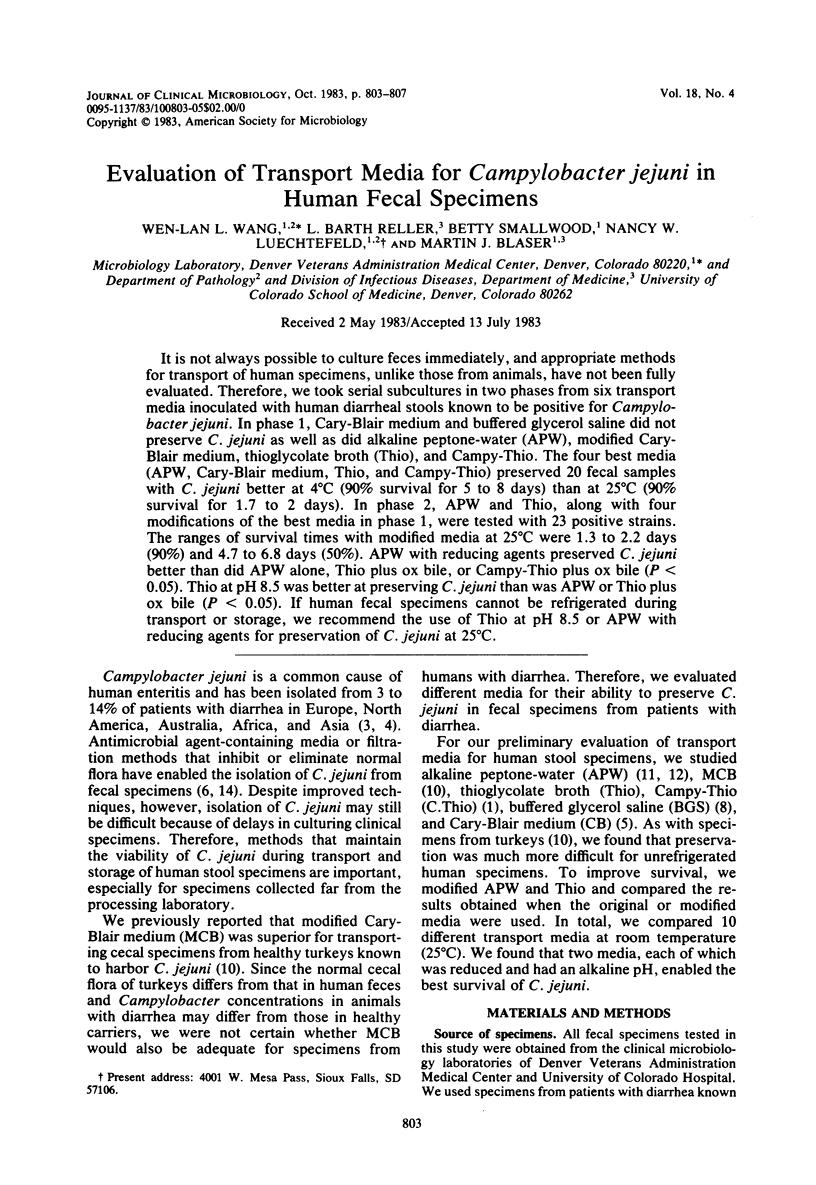
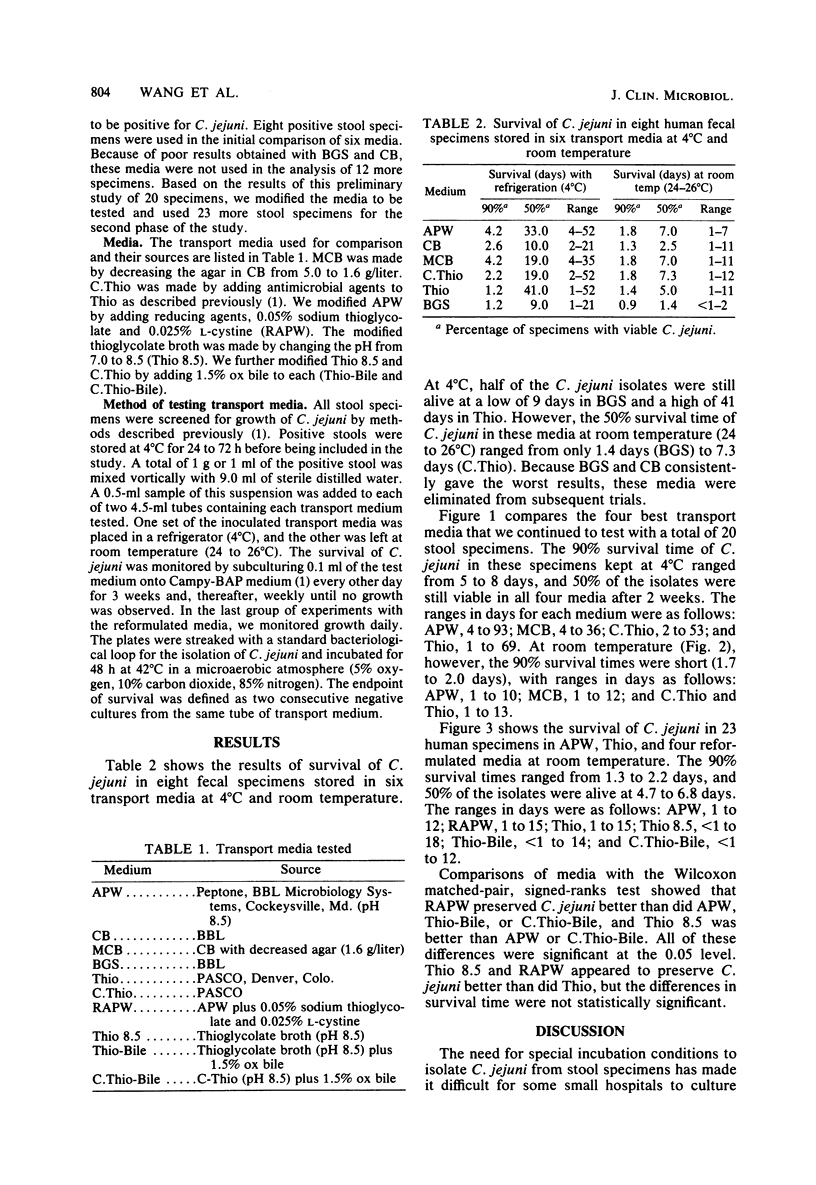
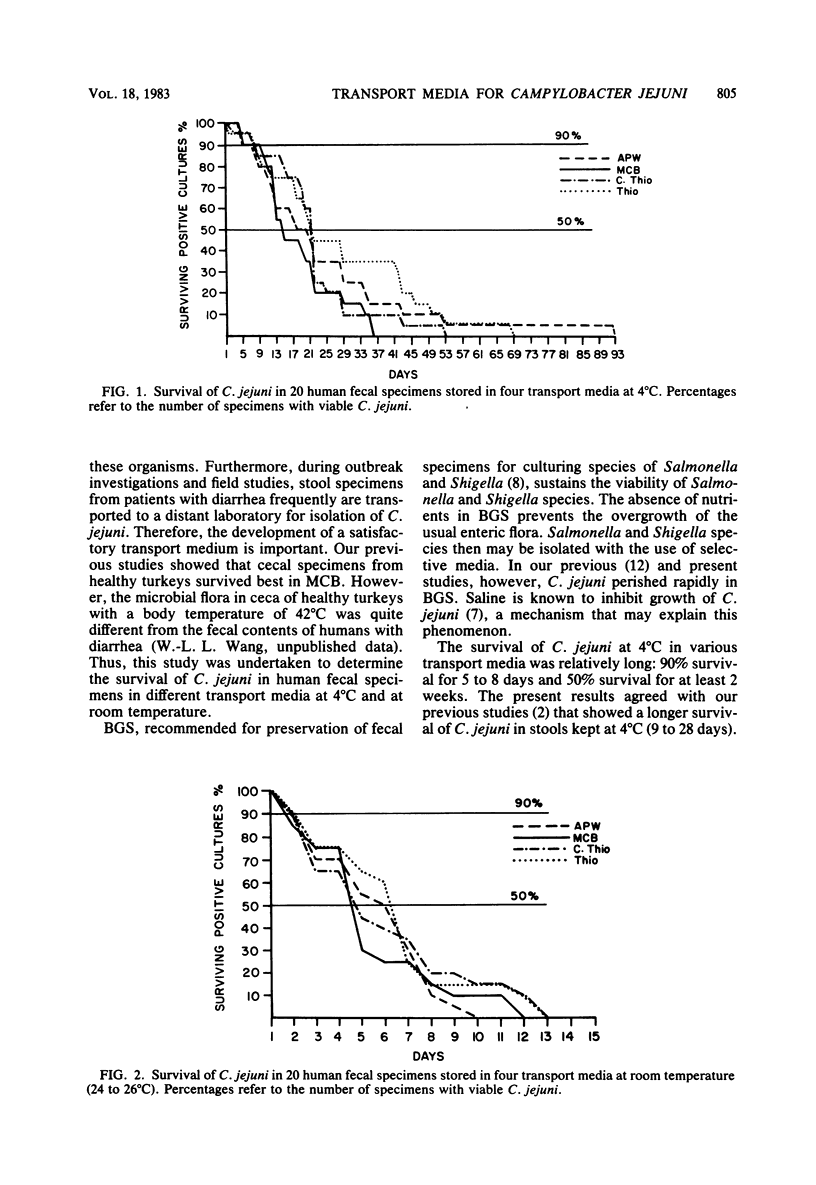
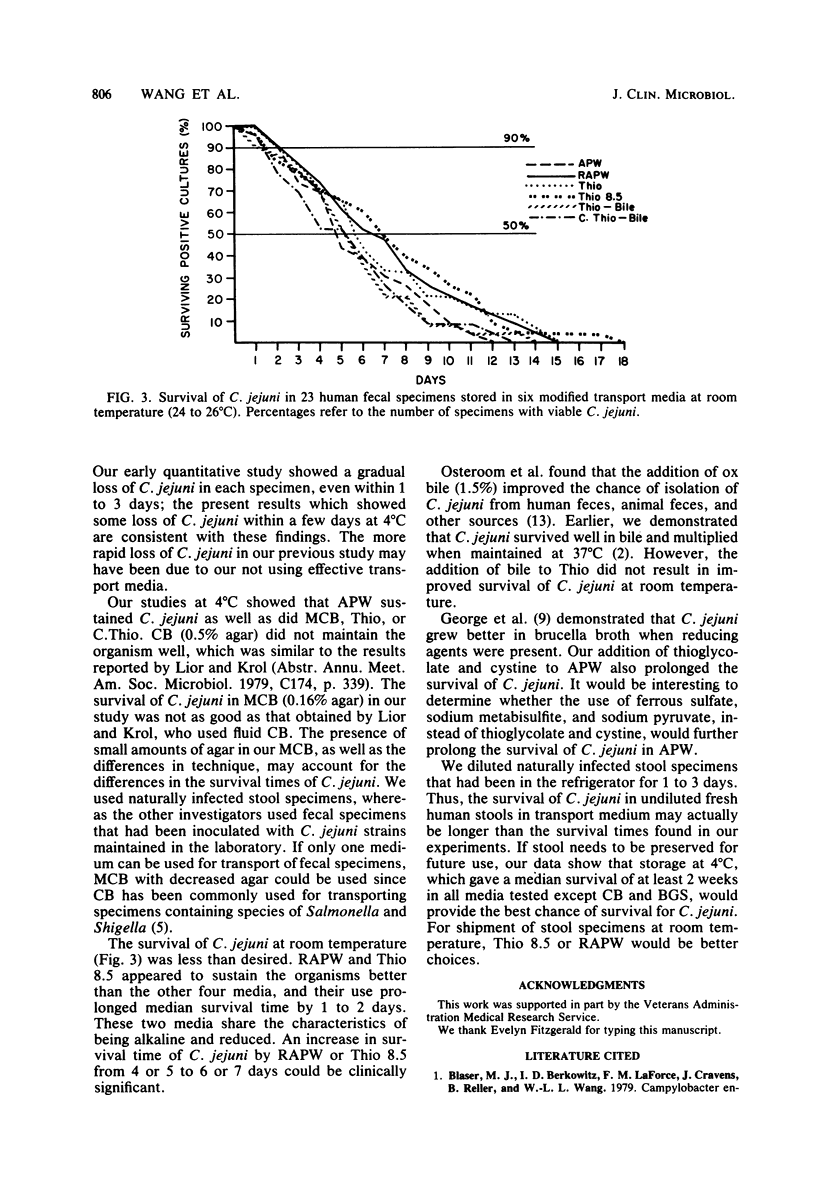
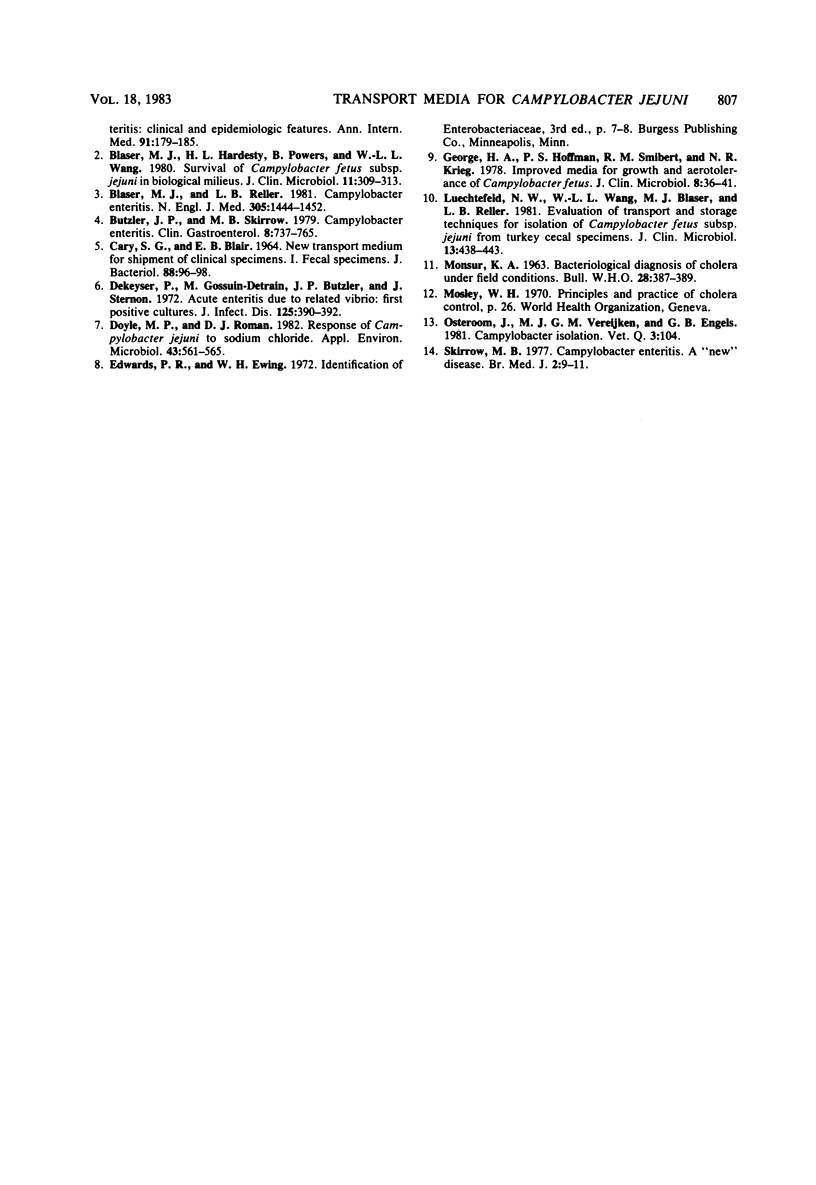
Selected References
These references are in PubMed. This may not be the complete list of references from this article.
- Blaser M. J., Berkowitz I. D., LaForce F. M., Cravens J., Reller L. B., Wang W. L. Campylobacter enteritis: clinical and epidemiologic features. Ann Intern Med. 1979 Aug;91(2):179–185. doi: 10.7326/0003-4819-91-2-179. [DOI] [PubMed] [Google Scholar]
- Blaser M. J., Hardesty H. L., Powers B., Wang W. L. Survival of Campylobacter fetus subsp. jejuni in biological milieus. J Clin Microbiol. 1980 Apr;11(4):309–313. doi: 10.1128/jcm.11.4.309-313.1980. [DOI] [PMC free article] [PubMed] [Google Scholar]
- Blaser M. J., Reller L. B. Campylobacter enteritis. N Engl J Med. 1981 Dec 10;305(24):1444–1452. doi: 10.1056/NEJM198112103052404. [DOI] [PubMed] [Google Scholar]
- Butzler J. P., Skirrow M. B. Campylobacter enteritis. Clin Gastroenterol. 1979 Sep;8(3):737–765. [PubMed] [Google Scholar]
- CARY S. G., BLAIR E. B. NEW TRANSPORT MEDIUM FOR SHIPMENT OF CLINICAL SPECIMENS. I. FECAL SPECIMENS. J Bacteriol. 1964 Jul;88:96–98. doi: 10.1128/jb.88.1.96-98.1964. [DOI] [PMC free article] [PubMed] [Google Scholar]
- Dekeyser P., Gossuin-Detrain M., Butzler J. P., Sternon J. Acute enteritis due to related vibrio: first positive stool cultures. J Infect Dis. 1972 Apr;125(4):390–392. doi: 10.1093/infdis/125.4.390. [DOI] [PubMed] [Google Scholar]
- Doyle M. P., Roman D. J. Response of Campylobacter jejuni to sodium chloride. Appl Environ Microbiol. 1982 Mar;43(3):561–565. doi: 10.1128/aem.43.3.561-565.1982. [DOI] [PMC free article] [PubMed] [Google Scholar]
- George H. A., Hoffman P. S., Smibert R. M., Krieg N. R. Improved media for growth and aerotolerance of Campylobacter fetus. J Clin Microbiol. 1978 Jul;8(1):36–41. doi: 10.1128/jcm.8.1.36-41.1978. [DOI] [PMC free article] [PubMed] [Google Scholar]
- Luechtefeld N. W., Wang W. L., Blaser M. J., Reller L. B. Evaluation of transport and storage techniques for isolation of Campylobacter fetus subsp. jejuni from turkey cecal specimens. J Clin Microbiol. 1981 Mar;13(3):438–443. doi: 10.1128/jcm.13.3.438-443.1981. [DOI] [PMC free article] [PubMed] [Google Scholar]
- Oosterom J., Vereijken M. J., Engels G. B. Campylobacter isolation. Vet Q. 1981 Apr;3(2):104–104. doi: 10.1080/01652176.1981.9693807. [DOI] [PubMed] [Google Scholar]
- Skirrow M. B. Campylobacter enteritis: a "new" disease. Br Med J. 1977 Jul 2;2(6078):9–11. doi: 10.1136/bmj.2.6078.9. [DOI] [PMC free article] [PubMed] [Google Scholar]


